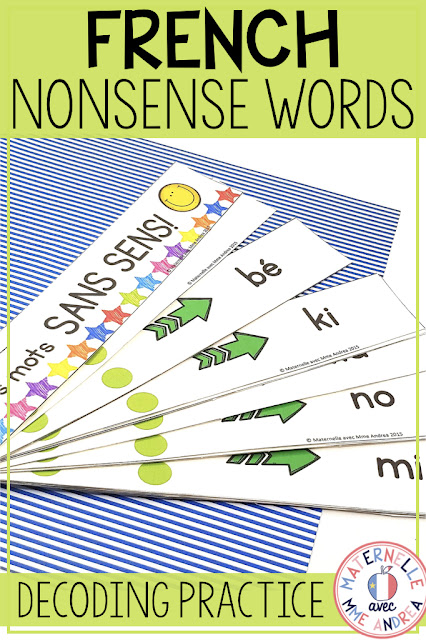Teaching five-year-olds to read is super fun, and one of my favourite parts of the job.
But, it isn’t always easy!
Most students catch on to the idea of looking at the picture to help them figure out an unknown word, and many grasp looking at the first letter pretty quickly, too.
BUT, struggles can ensue when you ask your students to look at the rest of the letters, and blend the sounds together.
My maternelle students can feel really overwhelmed and stressed out when I ask them to “read” a new word.
And, finding engaging ways to get my students to practice decoding/blending in French without discouraging them used to be challenging.
SO MANY FRENCH WORDS in their books have sons composés or letters that don’t even talk!
My kiddos would be so excited to come across a short word that they felt they could blend… like auto, for example.
They would take a deep breath, look at the word, and say “aaa…uuu…ttttt…ooo… ah-u-to!”
And, of course, I had to tell them that no, actually, ah-u-to isn’t actually a word, and even though they did correctly blend all of the letters, two of the letters work together to make a magic sound, etc. etc.
Frustrating for them, and frustrating for me!
I wanted to find a collection of short words where every letter says its sound, that would be easy for them to blend – there are piles of lists like that in English.
You know, like cat, hat, pig, pen, etc. etc.
But, there aren’t actually that many in French.
So, my solution?
Nonsense words!!!
Over the past few years, I have discovered that when my students and I are having fun playing with decoding nonsense words, they think it’s hilarious and can’t wait to discover what the next silly word they need to read will be.
Nonsense words are FUN, and my students are engaged, and getting valuable decoding practice, which they can then transfer to their books.
Curious about how we do it?
Read on to find out!
When using nonsense words to help us learn to decode, there are four main things we do to practice.
Nonsense word strip booklets
Disclaimer: I haven’t used these yet this year, because mine went missing last year when I moved classrooms and I haven’t gotten around to printing them again.
BUT, they work really well, and I do plan on printing them ASAP for my students who need to practice.
Basically, they are strips with a 2-3 letter nonsense words.
On the left side, each letter is shown separately, with a dot under each one.
The dots encourage your students to say each sound separately. Then, there is an arrow pointing to the nonsense word on the right side, to remind them to then blend the sounds together.
I use these as a warm-up activity, and I also send them home in their reading bags to practice with a family member.
Nonsense Words Board Game
We play this fun game if we get through everything else and still have some time left at the end of our guided reading block (it happens sometimes – not often, but it does!).
There are two versions of the game.
In the first game, students draw a card, and if they can decode it correctly, they spin the spinner and advance that many spaces.
In the second, there are nonsense words right on the game board.
Students spin the spinner and advance that many spaces. If they can read the word, they can stay there. If not, they back up one space.
Simple, but they get excited about it… and I get excited about the sneaky decoding practice
😉
Speed reading challenges
I send these speed reading blending challenges home in their reading bags, with a die.
(If they lose the die, they don’t get another and they have to just read it without that extra bit of excitement 😉 )
They roll it and then read all of the nonsense words in the corresponding column as quickly as they can.
I have boards for blending two letters, and boards for blending three.
Flash Cards
I also use the game cards from one of the board games as flash cards, generally as warm up.
The flash cards have two- and three-letter nonsense words on them.
I flash the cards, and each student reads them as quickly as possible. I set a sand timer, and we see how many we can do in a minute.
My favourite thing about these activities is that ALL of the letters “talk”.
It’s so frustrating when we have to tell our students one thing (make each letter’s sound and blend them together), and then have to correct them for saying the final consonant if there is no e after it, or for missing a son composé and saying both sounds, etc.
These nonsense words allow my students to feel confident and successful with blends.
Then, once they are at ease with them, we can talk about the exceptions to the rules, and they don’t feel frustrated.
Plus, anytime you can play with words, sounds, and language in the maternelle classroom is a plus!
Games and nonsense words are fun – simple as that! 🙂
If you’re interested in exploring nonsense words with your students, I have a pack on TPT with everything shown in this post.
You can check it out by clicking RIGHT HERE, or on any of the images in this post… including the one below.
I hope that nonsense words can help keep you from feeling frustrated about the lack of simple, short words for your students to blend in French!
Looking for more games & ideas to help your students with decoding?
Check out this blog post:
>>> Enseigner et pratiquer la fusion à travers des jeux












